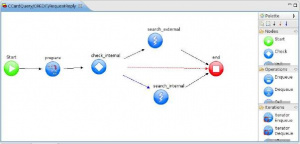GVExample CCardQuery
Contents
Description
This service has the scope of showing how GreenVulcano® ESB uses DataHandler for quering a DB and implements a Web Services.
CCardQuery Service executes the following operations:
- Receives a request Web Service from client, with a credit card number to be controlled.
- If this card is locally managed, reads the data using DataHandler.
- If this card is managed by an external system, forwards a Web Service request to that system.
- Returns the response to the client
VulCon Configuration
To configure CCardQuery service follow these steps:
- Define Systems, Channels and Operations
- Define the Services
- Implement the flows.
Defining Systems, Channels and Operations
To define a System, go to VulCon core view and insert the System CREDIT with the Channel CHANNEL_CREDIT_WS, with the following operations:
| Attribute | Value |
|---|---|
| name | DataHandler |
| DBOBuilder | name="CREDIT::CCardQuery" jdbc-connection-name="ds.test_gv" DHVariables:
|
| DBOBuilder/ DBOSelect | name="CCardQuery" transformation="CCardQuery" type="dbo" statement id="1" type="select" select p.NAME, cc.CNUMBER, cc.CREDIT, cc.ENABLED
from PERSON p, CREDIT_CARD cc
where p.ID = cc.ID_OWNER
and cc.CNUMBER = @{{CNUMBER}}
|
The operation defined in the DataHandler makes use of the data-transformation module for the data transformations that allow to have data in XML format. So, you need to define the following parameters into the GVDataTransformation section:
| Attribute | Value |
|---|---|
| DataSourceSet/LocalFSDataSource | formatHandled="xsl" name="XSLDataSource" repositoryHome="${{gv.app.home}}/gvdte/datasource/xsl" type="datasource" |
| XSLTransformation | name="CCardQuery" DataSourceSet="Default" XSLMapName="DataHandler/CREDIT/CCardQuery.xsl" type="transformation" |
| XSLTransformation | name="QueryExternalInput" DataSourceSet="Default" XSLMapName=" CREDIT_EXTERNAL/QueryExternalInput.xsl" type="transformation" |
| XSLTransformation | name="QueryExternalOutput" DataSourceSet="Default" XSLMapName=" CREDIT_EXTERNAL/QueryExternalOutput.xsl" type="transformation" |
Now insert the Service CREDIT_EXTERNAL with the Channel CHANNEL_CREDIT_EXT with the following operations:
| Attribute | Value |
|---|---|
| Name | QueryExternal |
| AxisWebServiceInvoker | operation="Query" ref-dp="EXTERNAL::QueryWSDataProvider" returnType="body-element" type="invoker" WSDLInfo:
|
Note that the easiest way to configure a Web Service with VulCon is using the Wizard. In this example we start from the ExternalCreditService.wsdl Web Service WSDL, present in folder ${{gv.app.home}}/xmlconfig/wsdl, that describes a withdrawal operation on a credit card.
From the Core view of VulCon®, right clicking the Services element, launch the Wizard Call Web Service and, after selecting the WSDL file, choose the parameters to create the GreenVulcano® ESB service.
After that you can modify your workflow through VulCon® Palette and set the elements as will be described in the next section.
Definition of Services
To define the CCardQuery Service, use the voice "Wizard new Service" (Right clicking the element Services) and set the following parameters:
| Attribute | Value |
|---|---|
| Service name | CCardQuery |
| Group | CREDIT_GRP |
| Scenario | Synchronous- Synchronous |
| Server (Participant) | system="CREDIT" channel="CHANNEL_CREDIT_WS" request operation= "DataHandler" |
A new Flow has been created and must be modified in its main steps. But first it is also needed to add a Participant with the attributes:
- system="CREDIT_EXTERNAL"
- channel="CHANNEL_CREDIT_EXT"
Flow implementation
To define the CCardQuery service Flow design it as shown in the picture:
The service receives a Web Service request from a client with a credit card number. If this card is managed locally, reads its data using Data Handler, otherwise forwards the request to an external system using Web Service.
The following table shows the parameters to be defined for each operations of the Flow:
| Attribute | Value |
|---|---|
| first-node | Prepare |
| Conditions/GVBufferCondition | condition="isInternalCCard" Property:
|
| ChangeGVBufferNode | dump-in-out="true" id="prepare" input="input" next-node-id="check_internal" clear-data="false" PropertyDef:
PropertyDef:
|
| GVRouting | condition="isInternalCCard" next-node-id="search_internal" |
| GVOperationNode | dump-in-out="false" id="search_internal" id-system="CREDIT" input="input" next-node-id="end" op-type="call" operation-name="DataHandler" output="output" |
| GVOperationNode | dump-in-out="false" id="search_external" id-system="CREDIT_EXTERNAL" input="input" next-node-id="end" op-type="call" operation-name="QueryExternal" InputServices:
OutputServices:
|
| GVEndNode | end-business-process="yes" id="end" op-type="end" output="output" |
